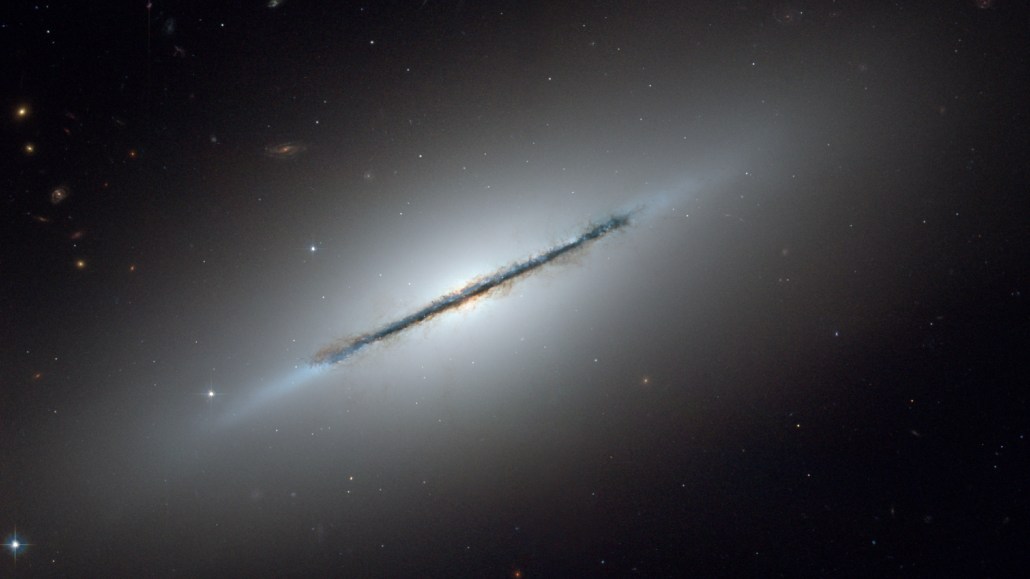
Lenticular galaxies like Messier 102, also known as the Spindle Galaxy, could provide new insight into how galaxies morph into different shapes.
NASA, ESA, Hubble Heritage Team/STScI/AURA, W. Keel/Univ. of Alabama, Tuscaloosa
The Milky Way might have once looked more like a legume than a starry whirlpool.
Over their unfathomably long lifetimes, spiral galaxies like the Milky Way are generally thought to morph into lentil-shaped “lenticular” galaxies and then into elliptical blobs (SN: 4/23/18). But an analysis of nearby galaxies suggests that our galaxy, and others like it, was once lenticular, astronomer Alister Graham reports in the July Monthly Notices of the Royal Astronomical Society. If correct, Graham’s proposed update to the evolutionary sequence of galaxies would rewrite the history of the Milky Way.
“Lenticulars have always been sort of the abandoned stepchild of [galaxy] morphology,” says astronomer Christopher Conselice of the University of Manchester in England, who wasn’t involved in the study. But this paper puts them into focus, he says, as being a major aspect of how galaxies change.
Lenticulars get their name from the way their entire halo of stars, when viewed edge on, bulges in the middle and thins out toward the sides, much like a lentil. These galaxies exhibit a confusing mix of properties that’s made their presumed place in the middle of galaxy evolution sequences rather suspect.
“We’ve known for a while that that’s almost certainly not correct,” Conselice says. Particularly puzzling is that lenticulars, despite their spiral-like disks, don’t have lots of gas, which hinders them from producing new stars. Spiral galaxies do have lots of star-forming gas, and scientists aren’t sure why lenticular galaxies don’t.
Graham, of Swinburne University of Technology in Hawthorn, Australia, found new clues to this mystery of galaxy evolution by considering black holes.
Most galaxies harbor a supermassive black hole in their center, and when galaxies merge, so do those black holes. This makes the mass of a galaxy’s black hole a kind of record of its past collisions. If a galaxy got big by gobbling up its neighbors rather than by sucking up surrounding gas, its black hole should be hefty relative to the swarm of stars that surrounds it.
Using images from the Hubble and Spitzer space telescopes, Graham compared the black hole and stellar masses of about 100 nearby galaxies. For galaxies of the same shape, he saw that black hole mass and stellar mass tend to be linked in a predictable way — except for the lenticular galaxies.
When Graham took a closer look at the lenticulars, he realized they are actually two distinct groups that had been lumped together: those that have lots of interstellar dust and those that do not. This division, which he previously reported in the May Monthly Notices of the Royal Astronomical Society, could have been a superficial aesthetic difference. But the galaxies’ black hole masses suggest otherwise.
Dust-poor and dust-rich lenticulars have entirely different relationships between their black hole masses and stellar masses, suggesting different histories and explaining the apparently scattered behavior of lenticular galaxies. The dusty galaxies tend to have a heftier supermassive black hole than the ones found in both spirals and dust-poor lenticulars. Dust-poor lenticulars are usually on the small side in terms of both black hole mass and stellar mass.
This led Graham to conclude that spiral galaxies are actually in between the two types of lenticulars, evolutionarily speaking. His new analysis suggests that dust-poor lenticulars become spirals after capturing small “satellite galaxies” and other minor mergers — bumping up their black hole masses — and scooping up nearby gas.
When spirals collide with other substantial galaxies, he proposes, they become dust-rich lenticulars — and indeed, he adds, every dust-rich lenticular in his dataset was previously recognized as the remnant of a spiral galaxy merger. Collisions between these dust-rich lenticulars are then enough to finally erode the galaxies’ discs of stars and destroy their dust, producing blobby elliptical galaxies.
Black holes are a good tracer of galaxy evolution, Conselice says, but the new sequence could be controversial. One issue, he says, is that lenticular galaxies in the nearby universe are usually such lightweights that they would need to merge tens or even hundreds of times — far more than the expected average of around three over 10 billion years — to form a large spiral galaxy.
But things might have been different in the early universe, he adds. Long ago, there could have been more massive lenticulars. Figuring that out might be possible with the James Webb Space Telescope, which can see incredibly faint infrared light, so is allowing scientists to peer farther away — and further back in time — than ever before (SN: 12/16/22).
“If you could look in the more distant universe, you could potentially see some of these galaxies when they’re first forming, or when they’re evolving,” Conselice says. “We could potentially really test this idea.”







